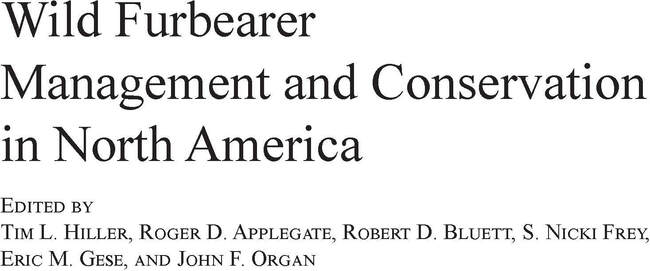For information about this book, including the Table of Contents, click here.
Published 10 October 2023
© 2023 Wildlife Ecology Institute
https://doi.org/10.59438/ZBDW8772
© 2023 Wildlife Ecology Institute
https://doi.org/10.59438/ZBDW8772
INTRODUCTION
Chemical immobilization is the use of approved pharmaceuticals to reduce an animal’s movements so that it can be safely handled by humans while reducing the potential for harm to itself. Although many species of furbearers can be physically restrained, this can be very psychologically and physiologically stressful to the animal as well as making tasks such as collecting invasive samples (e.g., blood), attaching radio-transmitters, and measuring for morphometrics more difficult than needed. Most modern immobilizing drugs for furbearers have been in use for decades and have been proven to be extremely safe and reliable. Immobilizing drugs can be used for safe removal of animals from traps; handling, and sampling; anesthetizing furbearers for painful procedures such as tooth extraction, transmitter implants, and wound management; transportation during translocation efforts; and removal of furbearers in problematic areas.
This chapter includes legalities of drug use, drug pharmacology, equipment, and animal medical considerations, and may be considered an update of information provided by Seal and Kreeger (1987). It is intended to give readers an overview of this field without in-depth technical discussions. A more technical and expansive coverage of chemical immobilization can be found in Kreeger et al. (2023). The most substantial changes since Seal and Kreeger (1987) concern the development of potent and antagonizable sedatives that reduce anesthetic doses and combinations of multiple drugs that provide efficacy and antagonist capabilities while increasing safety for both animals and humans.
Chemical immobilization is the use of approved pharmaceuticals to reduce an animal’s movements so that it can be safely handled by humans while reducing the potential for harm to itself. Although many species of furbearers can be physically restrained, this can be very psychologically and physiologically stressful to the animal as well as making tasks such as collecting invasive samples (e.g., blood), attaching radio-transmitters, and measuring for morphometrics more difficult than needed. Most modern immobilizing drugs for furbearers have been in use for decades and have been proven to be extremely safe and reliable. Immobilizing drugs can be used for safe removal of animals from traps; handling, and sampling; anesthetizing furbearers for painful procedures such as tooth extraction, transmitter implants, and wound management; transportation during translocation efforts; and removal of furbearers in problematic areas.
This chapter includes legalities of drug use, drug pharmacology, equipment, and animal medical considerations, and may be considered an update of information provided by Seal and Kreeger (1987). It is intended to give readers an overview of this field without in-depth technical discussions. A more technical and expansive coverage of chemical immobilization can be found in Kreeger et al. (2023). The most substantial changes since Seal and Kreeger (1987) concern the development of potent and antagonizable sedatives that reduce anesthetic doses and combinations of multiple drugs that provide efficacy and antagonist capabilities while increasing safety for both animals and humans.
Citation:
Kreeger, T. J. 2023. Chemical immobilization of furbearers. Pages 17.1–17.24 in T. L. Hiller, R. D. Applegate, R. D. Bluett, S. N. Frey, E. M. Gese, and J. F. Organ, editors. Wild furbearer management and conservation in North America. Wildlife Ecology Institute, Helena, Montana, USA. https://doi.org/10.59438/ZBDW8772
Citation:
Kreeger, T. J. 2023. Chemical immobilization of furbearers. Pages 17.1–17.24 in T. L. Hiller, R. D. Applegate, R. D. Bluett, S. N. Frey, E. M. Gese, and J. F. Organ, editors. Wild furbearer management and conservation in North America. Wildlife Ecology Institute, Helena, Montana, USA. https://doi.org/10.59438/ZBDW8772
Copyright 2024 Wildlife Ecology Institute



